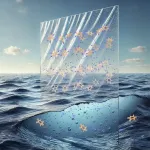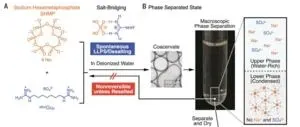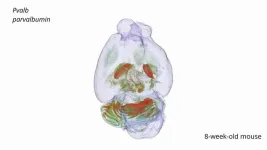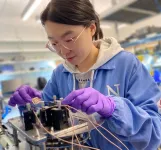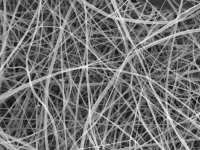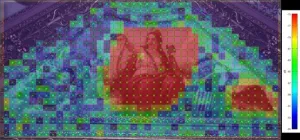(Press-News.org) Researchers led by Takuzo Aida at the RIKEN Center for Emergent Matter Science (CEMS) have developed a new durable plastic that won’t pollute our oceans. The new material is as strong as conventional plastics and biodegradable, but what makes it special is that it breaks down in seawater. The new plastic is therefore expected to help reduce harmful microplastic pollution that accumulates in oceans and soil and eventually enters the food chain. The experimental findings were published Nov 22 in Science.
Scientists have been trying to develop safe and sustainable materials that can replace traditional plastics, which are non-sustainable and harm the environment. While some recyclable and biodegradable plastics exist, one big problem remains. Current biodegradable plastics like PLA often find their way into the ocean where they cannot be degraded because they are water insoluble. As a result, microplastics—plastic bits smaller than 5 mm—are harming aquatic life and finding their way into the food chain, including our own bodies.
In their new study, Aida and his team focused on solving this problem with supramolecular plastics—polymers with structures held together by reversible interactions. The new plastics were made by combining two ionic monomers that form cross-linked salt bridges, which provide strength and flexibility. In the initial tests, one of the monomers was a common food additive called sodium hexametaphosphate and the other was any of several guanidinium ion-based monomers. Both monomers can be metabolized by bacteria, ensuring biodegradability once the plastic is dissolved into its components.
“While the reversable nature of the bonds in supramolecular plastics have been thought to make them weak and unstable,” says Aida, “our new materials are just the opposite.” In the new material, the salt bridges structure is irreversible unless exposed to electrolytes like those found in seawater. The key discovery was how to create these selectively irreversible cross links.
As with oil with water, after mixing the two monomers together in water, the researchers observed two separated liquids. One was thick and viscous and contained the important structural cross linked salt bridges, while the other was watery and contained salt ions. For example, when sodium hexametaphosphate and alkyl diguanidinium sulfate were used, sodium sulphate salt was expelled into the watery layer. The final plastic, alkyl SP₂, was made by drying what remained in the thick viscous liquid layer.
The “desalting” turned out to be the critical step; without it, the resulting dried material was a brittle crystal, unfit for use. Resalting the plastic by placing it in salt water caused the interactions to reverse and the plastic’s structure destabilized in a matter of hours. Thus, having created a strong and durable plastic that can still be dissolved under certain conditions, the researchers next tested the plastic’s quality.
The new plastics are non-toxic and non-flammable—meaning no CO2 emissions—and can be reshaped at temperatures above 120°C like other thermoplastics. By testing different types of guanidinium sulfates, the team was able to generate plastics that had varying hardnesses and tensile strengths, all comparable or better than conventional plastics. This means that the new type of plastic can be customized for need; hard scratch resistant plastics, rubber silicone-like plastics, strong weight-bearing plastics, or low tensile flexible plastics are all possible. The researchers also created ocean-degradable plastics using polysaccharides that form cross-linked salt bridges with guanidinium monomers. Plastics like these can be used in 3D printing as well as medical or health-related applications.
Lastly, the researchers investigated the new plastic’s recyclability and biodegradability. After dissolving the initial new plastic in salt water, they were able to recover 91% of the hexametaphosphate and 82% of the guanidinium as powders, indicating that recycling is easy and efficient. In soil, sheets of the new plastic degraded completely over the course of 10 days, supplying the soil with phosphorous and nitrogen similar to a fertilizer.
“With this new material, we have created a new family of plastics that are strong, stable, recyclable, can serve multiple functions, and importantly, do not generate microplastics,” says Aida.
END
Bye-bye microplastics: new plastic is recyclable and fully ocean-degradable
2024-11-21
ELSE PRESS RELEASES FROM THIS DATE:
Unveiling nature of metal-support interaction: AI-driven breakthrough in catalysis
2024-11-21
How can Artificial Intelligence (AI) help accelerate scientific discovery based on vast amounts of experimental data? A new study by Prof. LI Weixue's team from the University of Science and Technology of China (USTC) of the Chinese Academy of Sciences shows how this can be achieved in heterogonous catalysis. The results were recently published in Science.
By integrating interpretable AI with experimental data, domain knowledge, and first-principles simulations, the researchers established a general theory of metal-support interaction (MSI), which is one of the most important pillars in catalysis.
Supported metal catalysts ...
New imaging method enables detailed RNA analysis of the whole brain
2024-11-21
Researchers at Karolinska Institutet and Karolinska University Hospital have developed a groundbreaking microscopy method that enables detailed three-dimensional (3D) RNA analysis at cellular resolution in whole intact mouse brains. The new method, called TRISCO, has the potential to transform our understanding of brain function, both in normal conditions and in disease, according to the new study published in Science.
Despite great advances in RNA analysis, linking RNA data to its spatial context has long been a challenge, especially in intact 3D tissue volumes. The TRISCO method now makes it possible to perform three-dimensional RNA imaging of whole ...
Stability of perovskite solar cells doubled with protective coating
2024-11-21
Northwestern University scientists have developed a new protective coating that significantly extends the life of perovskite solar cells, making them more practical for applications outside the lab.
Although perovskite solar cells are more efficient and less expensive than traditional silicon solar cells, perovskite has, until now, been limited by its lack of long-term stability. Typically, perovskite solar cells uses an ammonium-based coating layer to enhance efficiency. While effective, ammonium-based layers degrade under environmental stress, such as heat and moisure.
Northwestern ...
Chemists create world’s thinnest spaghetti
2024-11-21
The world’s thinnest spaghetti, about 200 times thinner than a human hair, has been created by a UCL-led research team.
The spaghetti is not intended to be a new food but was created because of the wide-ranging uses that extremely thin strands of material, called nanofibers, have in medicine and industry.
Nanofibers made of starch – produced by most green plants to store excess glucose – are especially promising and could be used in bandages to aid wound healing (as the nanofiber mats are highly porous, allowing water and moisture in but keeping ...
Empowering neuroscience: Large open brain models released
2024-11-21
The hippocampus is one of the most fascinating brain regions. Associated with the formation of memories, it also helps us to navigate through the world without getting lost. Sensory cortices on the other hand play an important role in how we perceive our environment and make appropriate movements, and how our brains determine what to focus on and what to ignore. While both regions have been extensively studied and many of their secrets revealed, there is still a lot we do not understand about them due to the high complexity of ...
From traditional to technological: Advancements in fresco conservation
2024-11-21
MELVILLE, N.Y., Nov. 21, 2024 – Fresco painting, a technique that dates back to antiquity, involves applying dry pigments to wet plaster, creating stunning artwork that can last for centuries. Over time, however, these masterpieces often face degradation due to delamination, where decorative plaster layers separate from the underlying masonry or structural plaster. This deterioration can compromise the structural integrity of the artwork, necessitating restoration efforts.
Historically, conservators have gently knocked on the plaster with their knuckles or small mallets to assess the condition of the fresco. By listening to the emitted sound, they could identify the delaminated areas ...
Design and imagination as essential tools during the climate crisis
2024-11-21
In Nature Partner Journals, ten researchers advocate the use of imagination in tackling the climate crisis. They focus specifically on urbanising river deltas, which are of great social and economic importance and highly vulnerable to climate change. "We scientists should not merely outline doomsday scenarios," says Professor Chris Zevenbergen. "Create a vision for people to believe in and work towards.”
From doomscenarios to desired outcomes
Due to the climate crisis, urban river deltas ...
Innovating archaeology: HKU scholars utilize immersive 3D tech to document and study the human past
2024-11-21
Archaeologists from the Faculty of Arts at the University of Hong Kong (HKU) are revolutionising the excavation and documentation of ancient sites with cutting-edge 3D immersive technologies.
Archaeology studies the human past through the excavation of things people made and used thousands of years ago – from architecture to objects like pottery bowls and animal bones from meals. Although many excavation projects create digital 3D models of what they uncover, archaeologists need new ways to meaningfully use those data. Some projects share 3D models with the public as tourism and teaching tools – ...
What's the story, morning glory?
2024-11-21
Photos
Morning glory plants that can resist the effects of glyphosate also resist damage from herbivorous insects, according to a University of Michigan study.
The U-M researchers also found the reverse: plants treated with and susceptible to glyphosate, the active ingredient in the herbicide RoundUp, are also susceptible to damage from insects. This suggests that glyphosate, a herbicide humans have introduced into the environment, can disrupt the co-evolution of plants and their insect herbivores. ...
The unsolved mystery sounds of the Southern Ocean #ASA187
2024-11-21
MELVILLE, N.Y., Nov. 21, 2024 – Mysterious, repeating sounds from the depths of the ocean can be terrifying to some, but in the 1980s, they presented a unique look at an underwater soundscape.
In July 1982, researchers in New Zealand recorded unidentifiable sounds as a part of an experiment to characterize the soundscape of the South Fiji Basin. The sound consisted of four short bursts resembling a quack, which inspired the name of the sound “Bio-Duck.”
“The sound was so repeatable, we couldn’t believe at first that it was biological,” said ...
